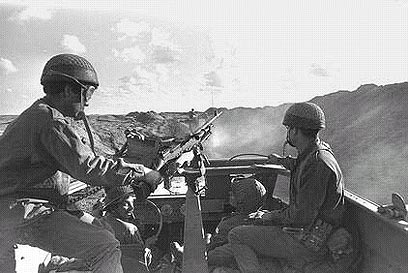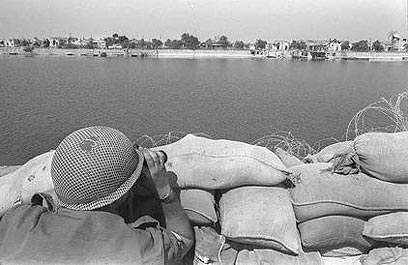
The War of Attrition (March 1969-August 1970) was fought between Egypt and Israel.
Egyptian President Gamal Nasser initiated the conflict in a bid to retake the Sinai Peninsula, which Israel had captured in the Six Day War. Subsequently, the majority of the fighting took place in and around the Suez Canal. Armistice was eventually brokered by the US, with neither side claiming any significant military feat.
The War of Attrition differed form other military campaigns Israel was involved in by the fact that most of it was conducted via "static fighting," in the sense that no territory was conquered or relinquished. Instead, the war was mostly made up of a series of armed raids conducted by both sides.
The Egyptian-Israeli border knew strife before the war was officially declared: October 1967 saw the Egyptian Navy sink the INS Eilat, a Z-Class destroyer, off the Rumani coast. A year later, Egyptian forces bombarded IDF outposts in the Suez Canal. These events led to a subsequent dispute as to the exact date in which the war broke out.

Israeli troops patrolling the Suez Canal (Archives: GPO)
Egypt also prompted unrest on Israel's other borders: The northern border saw shooting attacks emanating from Syria, Palestinian terrorists infiltrated the Jordan Valley and the West Bank, Jewish communities adjacent to the Jordanian border suffered Katyusha attacks and Jewish institutions around the world were targeted as well.
War breaks out
March of 1969 saw Nasser officially declare the Six Day War ceasefire agreement between Israel and Egypt null and void. The announcement was soon followed by aerial assaults mounted by the Egyptian Air Force on Israeli outposts in the Canal, in an attempt to force Israel to withdraw its troops. Israel responded by launching fierce air strikes on Egyptian targets, inflicting massive losses on the enemy.
Egyptian forces then began launching a series of small commando raids on the Suez Canal. The IDF opted to reinforce the outposts' fortification, but by July of 69' – after suffering 29 fatalities and 75 casualties – the IDF decided to react more forcibly: The air force began pounding both the front and rear Egyptian alignment, as ground troops staged deep incursions into Egyptian territory, venturing beyond the Suez Canal and targeting strategic Egyptian sites, such as power lines, refineries and bridges.
The multitude of Israeli strikes led Cairo to ask the USSR for military assistance. The latter sent 20,000 men, two fighter squadrons and advanced anti-aircraft ammunition, which in turn led to a decrease in the number of Israeli strikes. The actual, prolonged nature of the fighting and number of casualties suffered by the Israeli side resulted in a mass feeling of burnout among the IDF troops.

Suez Canal (Archives: GPO)
War's end
August 8, 1970 saw the American brokered ceasefire come into effect, with both Egypt and Israel essentially accepting the Rogers Plan – after then-US Secretary of State William Rogers – which called for a 90-day truce, the clearing the Suez Canal of all ships stuck there since the 1967 war, the implementation of UN Resolution 242, and mutual recognition of each state's sovereignty and independence. Egypt's Nasser died shortly after signing the armistice.
The outcome of the War of Attrition remains disputed to this day, as the lack of decisive, significant results in either side's favor left both Israel and Egypt lacking any real strategic advantage.
The War of Attrition claimed the lives of 1,424 Israeli soldiers and left more than 3,000 of them wounded. While the number of Egyptian fatalities remains unknown, they are believed to number around 10,000.














